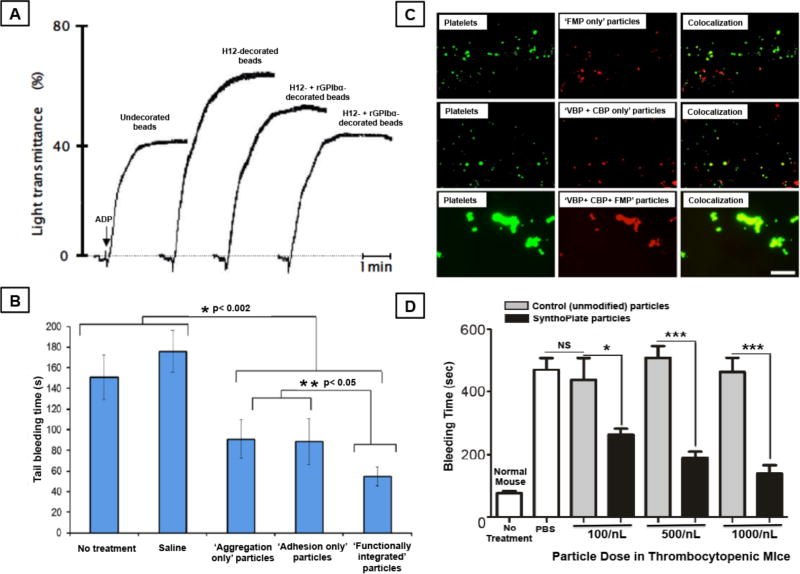Figure 14.
Selected results from hemostatic studies carried out with platelet-inspired ‘integrative’ particle technologies that combine platelet-relevant adhesion and aggregation mechanisms on a single particle platform. 14A shows platelet aggregometry studies where undecorated latex beads, or H12 peptide-decorated latex beads, or latex beads co-decorated with H12 peptides and rGPIbα fragments were added to ADP-activated platelets and the results showed that the co-decorated beads had no additional aggregation enhancement effects, possibly due to the masking of small H12 peptides by the large rGPIbα fragments; This masking effect could be resolved by utilizing heteromultivalent decoration of small peptides, as shown in the example in 14B where intravenous administration of liposomes heteromultivalently decorated with vWF-binding, collagen-binding and fibrinogen-mimetic peptides (functionally integrated particles) resulted in significant reduction in tail bleeding time in normal mice, compared to administration of liposomes bearing only pro-adhesive peptides (‘adhesion only’ particles) or liposomes bearing only pro-aggregatory peptides (‘aggregation only’ particles); such heteromultivalent decoration could be adapted onto other particle platforms, as shown in the example in 14C where discoid albumin particles (red fluorescent) surface-decorated heteromultivalently with all three peptides showed higher co-localization with active platelets (green fluorescent) to form visible aggregates in collagen-coated microfluidic channels, compared to particles bearing proaggregatory peptides only (‘FMP only’) or pro-adhesive peptides only (‘VBP + CBP’ only); 14D shows representative results from tail bleeding studies in thrombocytopenic mice where intravenously administered synthetic platelet (SynthoPlate™) particles (liposomes surface-decorated heteromutivalently with VBP, CBP and FMP) could dose-dependently reduce tail bleeding time, compared to administration of saline or control particles. Figure components adapted and reproduced with permission.[438,440,448,451] Copyright 2006, Springer; 2013, Elsevier; 2014, American Chemical Society and 2017, International Society on Thrombosis and Haemostasis.

